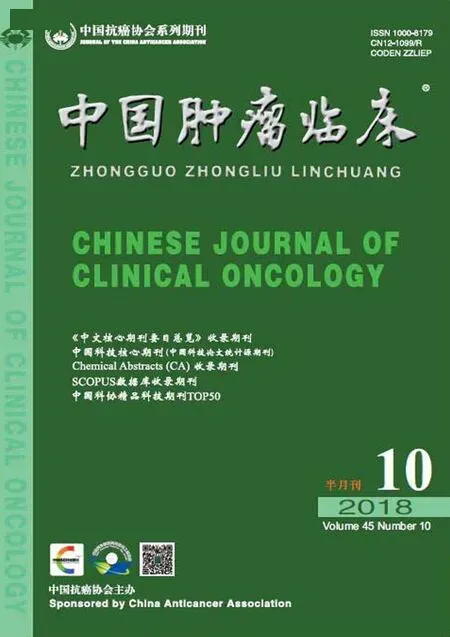PD-1/PD-L1抑制剂在淋巴瘤治疗中的研究进展*
2018-01-19综述审校
综述 审校
淋巴瘤为高度异质性疾病,在全球的发病率和死亡率逐年升高,目前治疗方式主要为传统放化疗。虽然利妥昔单抗的应用使部分淋巴瘤患者的长期生存率获得明显改善,但复发难治性淋巴瘤的治疗仍然面临着挑战。近年来,肿瘤免疫治疗迅速发展。程序性死亡受体-1(programmed death-1,PD-1)及其配体(pro⁃grammed death-ligand 1,PD-L1)结合诱导T细胞的凋亡,使肿瘤细胞发生免疫逃逸。而通过阻断PD-1/PD-L1信号通路可使T细胞活化增强,识别和杀伤肿瘤细胞,有效抑制肿瘤生长,成为肿瘤免疫治疗的有效新靶点。2016年5月美国食品药品监督管理局(FDA)批准PD-1抗体nivolumab用于治疗复发难治性霍奇金淋巴瘤(relapsed refractory Hodgkin's lymphoma,r/rHL)患者,为淋巴瘤治疗开启新的篇章。本文将从PD-1/PD-L1信号通路出发,陈述其机制在淋巴瘤治疗中的研究进展和联合治疗等方面进行综述。
1 PD-1/PD-L1通路
PD-1是一种免疫共抑制分子,主要表达在活化的CD4+、CD8+T、B细胞、NK细胞和髓系细胞上。属于CD28家族成员,是一种由V样结构域、免疫受体酪氨酸抑制基序(tyrosine inhibitory motif of immune receptor,ITIM)和免疫受体酪氨酸转换基序(immunoreceptor tyrosinebased switch motif,ITSM)共同组成的跨膜蛋白。PD-1共有2个配体,分别为PD-L1(B7-H1,CD274)和PD-L2(B7-DC,CD273),PD-L1在正常组织中的表达十分有限,主要见于滤泡状细胞、巨噬细胞及淋巴组织中,而PD-L2的表达水平更低,可见于活化的CD4+、CD8+T、髓系树突状细胞、单核细胞、内皮细胞和胎盘合体滋养细胞[1]。由于受到胞外细胞因子的刺激或某些通路的持续激活,肿瘤细胞及肿瘤微环境中PD-1/PD-L1表达显著上调,并且与肿瘤的恶性程度及预后密切相关。在霍奇金淋巴瘤(Hodgkin's lymphoma,HL)中,经典型霍奇金淋巴瘤(classical Hodgkin's lymphoma,cHL)PD-1表达最高,在肿瘤浸润T细胞及外周血中均呈高表达,其中又以富于淋巴细胞型表达最为明显,而结节硬化型相对较低[2]。cHL患者9p24.1基因明显扩增导致该基因上的PD-L1和PD-L2基因拷贝数增加,从而过表达PD-L1和PD-L2[3],扩增的还有9p24.1染色体上的JAK2基因,通过激活JAK-STAT信号通路进一步促进PD-L1表达[4]。PD-1/PD-L1表达在非霍奇金淋巴瘤(non-Hodgkin's lymphoma,NHL)中呈不同程度的增高。BNHL以弥漫大B细胞淋巴瘤(diffuse large B cell lym⁃phoma,DLBCL)[5-6]、滤泡性淋巴瘤(follicular lymphoma,FL)[7]为主,同时受9p24.1基因紊乱影响的如原发性纵隔型大B细胞淋巴瘤(primary mediastinal large B cell lymphoma,PMBL)、原发性中枢神经系统淋巴瘤(primary central nervous system lymphoma,PCNSL)和原发性睾丸淋巴瘤(primary testicular lymphoma,PTL)中PD-L1呈异常过表达。此外,在结外NK/T细胞淋巴瘤、间变性大细胞淋巴瘤和T细胞白血病/淋巴瘤等T-NHL中也可检测到PD-L1的高表达[8-9]。
2 PD-1/PD-L1作用机制
正常情况下,组织细胞表面的PD-1与其配体PD-L1结合后,能产生负性调节,抑制T细胞过度增殖活化,维持正常的免疫平衡。但是在多种肿瘤细胞及肿瘤微环境中,过表达的PD-1受体与其配体PD-L1结合可抑制T细胞的活化,阻断免疫应答,使肿瘤细胞产生免疫逃逸,促进肿瘤生长。其机制可能为:1)PD-1与PD-L1结合后ITSM结构域中的酪氨酸发生磷酸化,招募更多的酪氨酸磷酸酶SHP2,引起TCR相关信号传导分子去磷酸化,抑制信号传导,最终导致T细胞耗竭及失能[10];2)PD-1抑制了ZAP70蛋白磷酸化,PKC-θ激酶活化,进而阻碍IL-2产生及T细胞活化[11];3)PD-1还可以通过抑制糖酵解和促进脂肪酸氧化来抑制效应T细胞的发育[12]。
3 PD-1/PD-L1抗体在淋巴瘤治疗中的应用
目前,以PD-1、PD-L1为免疫靶点的相关药物已被批准用于临床治疗,抗PD-1单克隆抗体以niv⁃olumab、pembrolizumab和 pidilizumab为代表,而抗PD-L1单克隆抗体主要为atezolizumab和durvalum⁃ab,并已取得部分进展。
3.1 PD-1抗体
3.1.1 nivolumab nivolumab是一种全人源性IgG4型抗PD-1单克隆抗体,在其Ⅰb期临床研究中共入组23例r/rHL患者,结果显示客观缓解率(objective response rate,ORR)高达87%[10]。鉴于其显著疗效,2016年FDA加速批准了nivolumab用于治疗自体干细胞移植(au⁃tologous stem cell transplantation,ASCT)和brentuximab vedotin治疗失败的HL患者,推荐用法为3 mg/kg,每2周1次的用量,历时60 min静脉注射。Younes等[13]开展的临床Ⅱ期试验(NCT02181738)进一步证实了nivolumab治疗r/rHL患者的临床疗效,该研究共入组80例经ASCT和brentuximab vedotin失败的HL患者,所有患者均接受nivolumab 3 mg/kg,每2周1次,直至疾病进展、死亡或不可耐受。结果显示ORR为66.3%,中位反应时间为7.8个月。最常见的药物不良反应包括疲劳(25%)、输液相关反应(20%)、皮疹(16%),3~4级不良反应主要为中性粒细胞减少(5%)和脂肪酶的增加(5%)。2017美国血液学会(ASH)年会上报告了意大利开展的扩大试验结果[14],133例患者ORR为68%,完全缓解(complete response,CR)率为15%,部分缓解(partial response,PR)率为53%。在10.6个月的中位随访中,1年无进展生存(progression free survival,PFS)率和总生存(overall survival,OS)率分别为61.4%和89.0%,并且有31例(23%)患者行后续移植。这与Younes等[13]的研究结果一致,证实了nivolumab对r/rHL患者的治疗是安全有效的。而在Lesokhin等[15]开展的nivolumab临床Ⅰ期试验不再局限于r/rHL,该研究入组了FL患者10例,DLBCL患者11例,外周T细胞淋巴瘤患者5例,随访中位时间为66.6周,ORR分别为40%、36%和40%。研究结果显示,nivolumab在其他类型的淋巴瘤中均具有良好前景。3.1.2 pembrolizumab pembrolizumab是一种全人源性IgG4型抗PD-1单克隆抗体,已被证实在多种实体肿瘤中具有良好的耐受性。pembrolizumab临床Ⅰ期试验(NCT01953692,KEYNOTE-013)[16]入组了 31 例 bren⁃tuximab vedotin治疗失败的cHL患者,所有患者均给予pembrolizumab 10 mg/kg静脉注射治疗,研究结果显示ORR为65%,CR率为16%,PR率为48%。最常见的药物不良事件为甲状腺功能减退症(16%)、腹泻(13%)、恶心(13%)和肺炎(10%)。并且经过2.5年的后期随访研究,入组27例患者,难治性HL的ORR为56%,复发性HL的ORR为75%,中位PFS(median PFS,mPFS)为11.4、6.0和12.0个月,OS分别为100%和87%[17]。随后开展的pembrolizumab临床Ⅱ期试验(NCT02453594,KEYNOTE-087)[18]共入组210例r/rHL患者,分为3组:经BV及ASCT治疗后的r/rHL(第1组),共69例;经BV治疗失败而未行ASCT的HL(第2组),共81例;经ASCT治疗后复发而未行BV治疗的HL(第3组),共60例。所有患者每3周静脉注射pembrolizumab 200 mg,12周评估1次。截至数据终止,中位治疗周期为13次,3组的OR率分别为73.9%、64.2%和70.0%,CR率分别为21.7%、24.7%和20.0%。常见的药物不良反应为甲状腺功能减退症(12.4%)和发热(10.5%),其中3~4级不良反应为中性粒细胞减少症(2.4%)、呼吸困难(1%)和腹泻(1%)。该试验表明,pembrolizumab在r/rHL治疗中同样有效,与nivolumab[13]相比不良反应发生率更低,耐受性更好。基于上述数据,2017年3月pembrolizumab被FDA批准治疗成人和儿童r/rcHL及3线以上治疗后复发的患者,成为第2个获批治疗淋巴瘤的PD-1抑制剂,推荐用法为200 mg,每3周1次,历时60 min静脉注射。除此之外,pembrolizumab治疗复发/难治性原发性纵隔大B细胞淋巴瘤(primary mediastinal B cell lymphoma,PMB⁃CL)[19]、左旋门冬酰胺酶治疗失败后的NK/T细胞淋巴瘤[20]等临床试验也在相继开展。
3.1.3 pidilizumab(CT-011) pidilizumab 是一种全人源性IgG1型抗PD-1单克隆抗体。一项在ASCT治疗后DLBCL患者开展的临床Ⅱ期试验(NCT00532259)中,该试验共入组66例DLBCL患者均接受pidilizumab 1.5 mg/kg,每6周1次,共3次。结果显示16个月PFS为72%,OS为85%,常见的3~4级的药物不良反应为中性粒细胞减少症(19%)和血小板减少(8%)[21]。这与仅行ASCT治疗的结果相比[22],后续加用pidilizumab治疗明显改善PFS(52%vs.72%)和OS(60%vs.85%)。
3.2 PD-L1抗体
3.2.1 atezolizumab atezolizumab是一种人源性IgG1型抗PD-L1单克隆抗体,已被FDA批准用于局部晚期或转移性尿路上皮癌和非小细胞肺癌(non-small cell lung cancer,NSCLC)。atezolizumab在淋巴瘤中的临床试验主要是与其他免疫抑制联合治疗FL及DLBCL。atezolizumab联合obinutuzumab(CD20单抗)在复发难治性FL和DLBCL的临床Ⅰ期试验(NCT02220842)中[23],所有患者在第1次接受obinutuzumab100mg(d1)、900mg(d2)及1 000 mg(d8,d15),在第2~8次每3周静脉注射atezolizumab(1 200 mg)和 obinutuzumab(1 000 mg)。atezolizumab(1 200 mg,每3周1次)单药维持治疗6个月。49例DLBCL和FL患者的ORR分别为16%和57%,17例患者中15例由于疾病进展而死亡,2例原因不明。最常见的3~4级不良反应为疼痛(8.2%)、贫血(6.1%)和中性粒细胞减少(6.1%)。
3.2.2 durvalumab durvalumab是全人源化IgG1型抗PD-L1单克隆抗体。主要用于膀胱癌的治疗,多项淋巴瘤治疗的临床试验正在招募中。包括durvalumab治疗复发/难治性B细胞淋巴瘤或白血病临床Ⅰ/Ⅱ期研究(NCT02733042)[24]、R-CHOP方案联合durvalumab±来那度胺治疗高危DLBCL患者的临床Ⅱ期研究(NCT03003520)[25]等。
4 PD-1/PD-L1抑制剂的联合治疗
虽然PD-1/PD-L1抑制剂已在临床试验中初见成效,但是单药使用的CR率并不显著,其疗效持久性仍需长期随访观察,这与肿瘤信号通路受多种因素影响有关。PD-1/PD-L1抑制剂与其他抗肿瘤药物联合应用受到广泛关注。PD-1/PD-L1抑制剂可激活T细胞,提高抗体依赖的细胞毒副作用,而CD20、CD30单抗是通过ADCC作用来杀伤B细胞来源的肿瘤,两者联合具有协同作用,增强抗肿瘤效果。Herrera等[26]开展的一项nivolumab联合brentuximab vedotin治疗r/rcHL的临床Ⅰ/Ⅱ期试验(NCT02572167)结果显示,60例患者中ORR为85%,CR率为62%,较nivolumab单药[13]使用临床获益更为明显。另外,PD-1/PD-L1抗体使失能的T细胞恢复抗肿瘤免疫应答,阻断CTLA-4,能够增强T细胞的活化和增殖,PD-1/PD-L1抑制剂与CTLA-4抗体联合使用可以增强T细胞的抗肿瘤活性,产生持久的临床效应。在既往研究中[27-28],联合治疗在恶性黑色瘤、晚期NSCLC疗效显著。nivolumab联合ipilimumab(NCT 02681302)、durvalumab联合tremelimumab(NCT0254 9651)等相关临床试验正在开展中,期待取得良好的疗效。研究还发现,PD-1/PD-L1抑制剂可增加化疗敏感性,联合使用能提高化疗效果。
5 结语
PD-1/PD-L1抑制剂在近年来肿瘤治疗领域取得了突破性进展,诸多治疗经验和研究结果表明其在淋巴瘤治疗中具有良好的临床疗效和安全性,但是仍处于免疫治疗的初期,对PD-1/PD-L1抑制剂的认知尚不全面,亟需大量的临床试验来证实其抗肿瘤活性及安全性,探讨最佳的联合治疗方法,控制相关不良反应,为更多的淋巴瘤患者带来生存获益。
[1]Ok CY,Young KH.Targeting the Programmed death‐1 pathway in lymphoid neoplasms[J].Cancer Tre Rev,2017,62(3):54‐99.
[2]Muenst S,Hoeller S,Dirnhofer S,et al.Increased programmed death‐1+tumor‐infiltrating lymphocytes in classical Hodgkin lymphoma substantiate reduced overall survival[J].Human Path,2009,40(12):1715‐1722.
[3]Roemer MGM,Advani RH,Ligon AH,et al.PD‐L1 and PD‐L2 genetic alterations define classical hodgkin lymphoma and predict outcome[J].J Clin Oncol,2016,34(23):2690‐2697.
[4]Green MR,Monti S,Rodig SJ,et al.Integrative analysis reveals selective 9p24.1 amplification,increased PD‐1 ligand expression,and further induction via JAK2 in nodular sclerosing Hodgkin lymphoma and primary mediastinal large B‐cell lymphoma[J].Blood,2010,116(17):3268‐3277.
[5]Kiyasu J,Miyoshi H,Hirata A,et al.Expression of programmed cell death ligand 1 is associated with poor overall survival in patients with diffuse large B‐cell lymphoma[J].Blood,2015,126(19):2193‐2201.
[6]Kwon D,Kim S,Kim PJ,et al.Clinicopathological analysis of pro‐grammed cell death 1 and programmed cell death ligand 1 expression in the tumour microenvironments of diffuse large B cell lymphomas[J].Histopath,2016,68(7):1079‐1089.
[7]Carreras J,Lopez‐Guillermo A,Roncador G,et al.High numbers of tumor‐infiltrating programmed cell death 1‐positive regulatory lym‐phocytes are associated with improved overall survival in follicular lymphoma[J].J Clin Oncol,2009,27(9):1470‐1476.
[8]Han L,Liu F,Li R,et al.Role of programmed death ligands in effective T cell interactions in extranodal natural killer/T cell lymphoma[J].Oncol Lett,2014,8(4):1461‐1469.
[9]Miyoshi H,Kiyasu J,Kato T,et al.PD‐L1 expression on neoplastic or stromal cell is respectively poor or good prognostic factor for adult T‐cell leukemia/lymphoma[J].Blood,2016,128(10):1374.
[10]Ansell SM,Lesokhin AM,Borrello I,et al.PD‐1 blockade with nivolumab in relapsed or refractory Hodgkin's lymphoma[J].New Engl J Med,2015,372(4):311‐319.
[11]SheppardKA,Fitz L J,Lee JM,et al.PD‐1inhibits T‐cell receptor induced phosphorylation of the ZAP70/CD3ζ signalosome and downstream signaling to PKCθ[J].FEBS Lett,2004,574(1‐3):37‐41.
[12]Patsoukis N,Bardhan K,Chatterjee P,et al.PD‐1 alters T‐cell metabolic reprogramming by inhibiting glycolysis and promoting lipolysis and fatty acid oxidation[J].Nat Communic,2015,(6):6692.
[13]Younes A,Santoro A,Shipp M,et al.Nivolumab for classical Hodgkin's lymphoma after failure of both autologous stem‐cell transplantation and brentuximabvedotin:a multicentre,multicohort,single‐arm phase 2 trial[J].Lancet Oncol,2016,17(9):1283‐1294.
[14]Santoro A,D'alo F,Zinzani PL,et al.Real‐world data of nivolumab in classical hodgkin lymphoma:results from the Italian expanded access programme[J].Blood,2017,130(1):5171.
[15]Lesokhin AM,Ansell SM,Armand P,et al.Nivolumab in patients with relapsed or refractory hematologic malignancy:preliminary results of a phaseⅠb study[J].J Clin Oncol,2016,34(23):2698‐2727.
[16]Armand P,Shipp MA,Ribrag V,et al.PD‐1 blockade with pembroli‐zumab in patients with classical Hodgkin lymphoma after brentux‐imabvedotin failure:safety,efficacy,and biomarker assessment[J].Blood,2015,126(23):584‐584.
[17]Armand P,Shipp MA,Ribrag V,et al.Pembrolizumab in patients with classical hodgkin lymphoma after brentuximab vedotin failure:long‐term efficacy from the phaseⅠb keynote‐013 study[J].Blood,2016,128(22):1108.
[18]Chen R,Zinzani PL,Fanale MA,et al.PhaseⅡstudy of the efficacy and safety of pembrolizumab for relapsed/refractory classic hodgkin lymphoma[J].J Clin Oncol,2017,35(19):2125.
[19]Zinzani PL,Ribrag V,Moskowitz CH,et al.Safety&tolerability of pembrolizumab in patients with relapsed/refractory primary medi‐astinal large B‐cell lymphoma[J].Blood,2017,130(3):267.
[20]Kwong YL,Chan TSY,Tan D,et al.PD‐1 blockade with pembrolizumab is highly effective in relapsed or refractory NK/T‐cell lymphoma failing L‐asparaginase[J].Blood,2017,129(17):2437‐2442.
[21]Armand P,Nagler A,Weller EA,et al.Disabling immune tolerance by programmed Death‐1 blockade with pidilizumab after autologous hematopoietic stem‐cell transplantation for diffuse large B‐cell lym‐phoma:results of an international phaseⅡtrial[J].J Clin Oncol,2013,31(33):4199‐4206.
[22]Armand P,Welch S,Kim HT,et al.Prognostic factors for patients with diffuse large B cell lymphoma and transformed indolent lymphoma undergoing autologous stem cell transplantation in the positron emission tomography era[J].Bri J Haemat,2013,160(5):608‐617.
[23]Palomba ML,Till BG,Park SI,et al.A phaseⅠB study evaluating the safety and clinical activity of atezolizumab combined with obinutu‐zumab in patients with relapsed or refractory non‐hodgkin lymphoma(NHL)[J].Hemat Oncol,2017,35(S2):137‐138.
[24]Witzig TE,Casulo C,Cartron G,et al.PhaseⅠ/Ⅱstudy of durvalumab(anti–PD‐L1antibody)as monotherapy andincombinationinpatients with lymphoma or chronic lymphocytic leukemia[J].J Clin Oncol,2017.DOI:10.1200/JCO.2017.35.15_suppl.
[25]Jaeger U,Kalakonda N,Everaus H,et al.PhaseⅡstudy of durvalumab(anti‐PD‐L1)combined with either R‐chop or lenalidomide and R‐chop in previously untreated,high‐risk diffuse large B‐cell lymphoma[J].Hemat Oncol,2017,35(S2):419‐420.
[26]Herrera AF,Bartlett NL,Ramchandren R,et al.Preliminary results from a phaseⅠ/Ⅱstudy of brentuximab vedotin in combination with nivolumab in patients with relapsed or refractory Hodgkin lymphoma[J].Blood,2016,128(22):1105.
[27]Hellmann MD,Rizvi NA,Goldman JW,et al.Nivolumab plus ipilimumab as first‐line treatment for advanced non‐small‐cell lung cancer(CheckMate012):resultsof anopen‐label,phaseⅠ,multicohortstudy[J].Lancet Oncol,2017,18(1):31‐41.
[28]Antonia S,Goldberg SB,Balmanoukian A,et al.Safety and antitumour activity of durvalumab plus tremelimumab in non‐small cell lung cancer:a multicentre,phaseⅠb study[J].Lancet Oncol,2016,17(3):299‐308.
